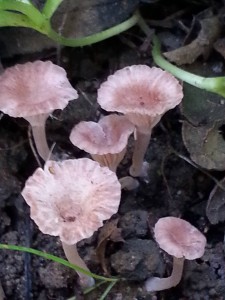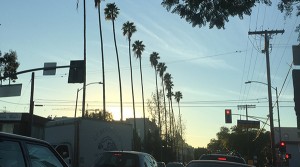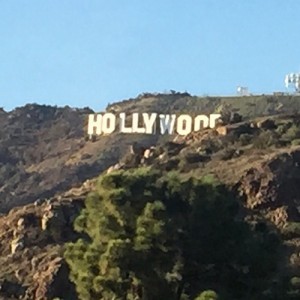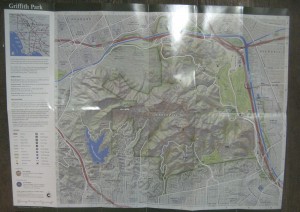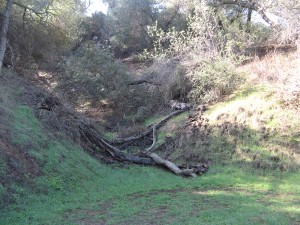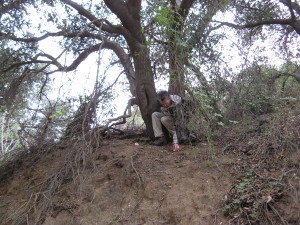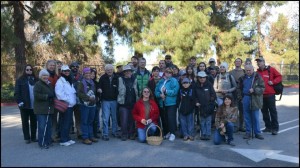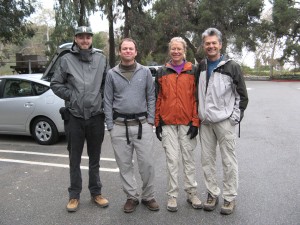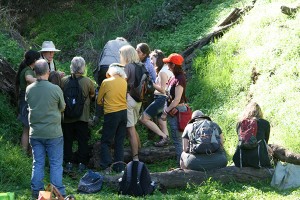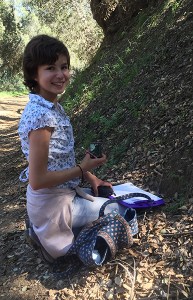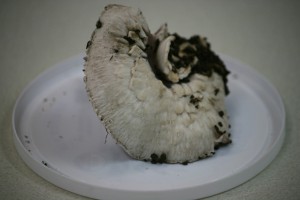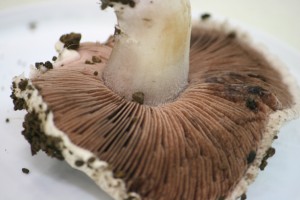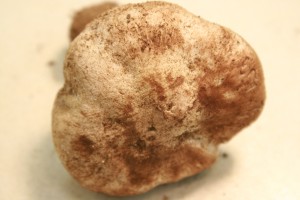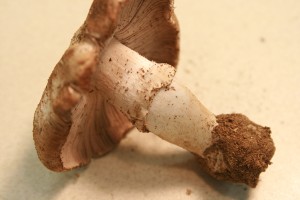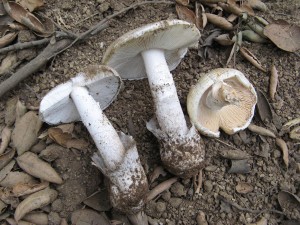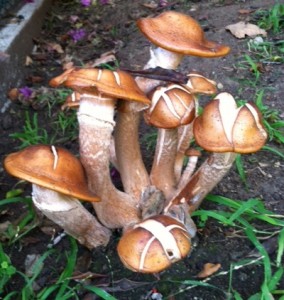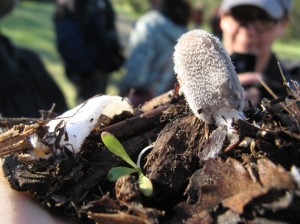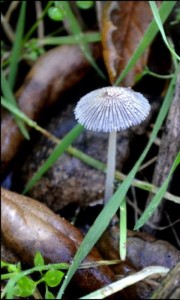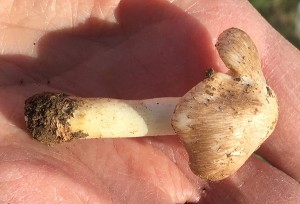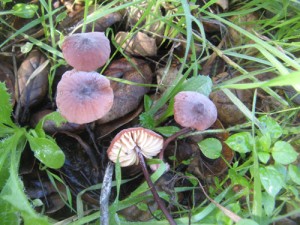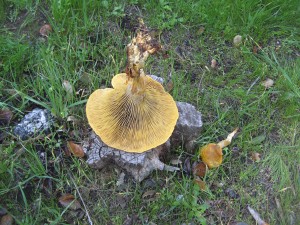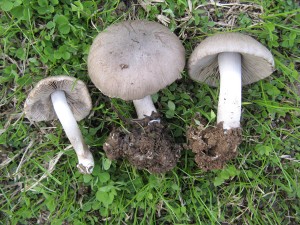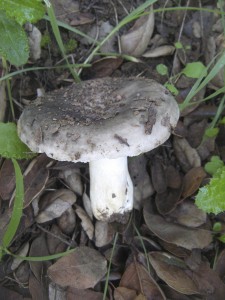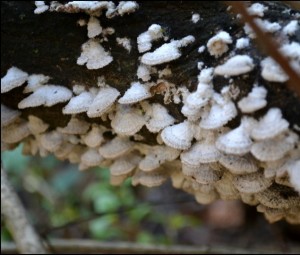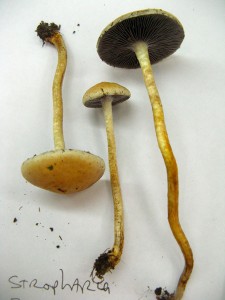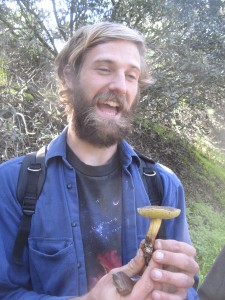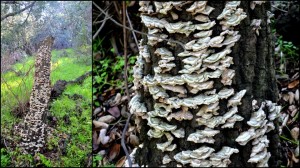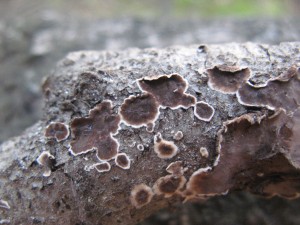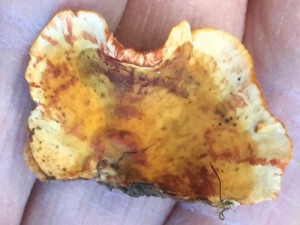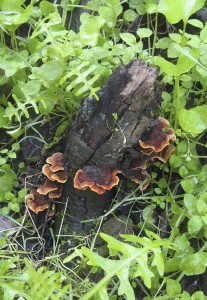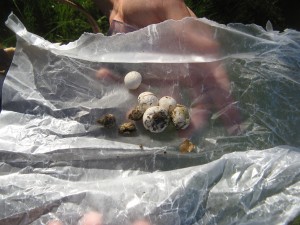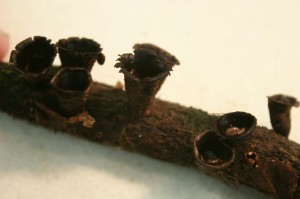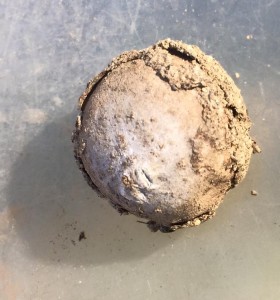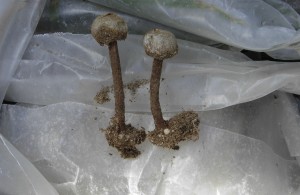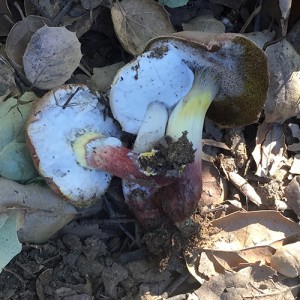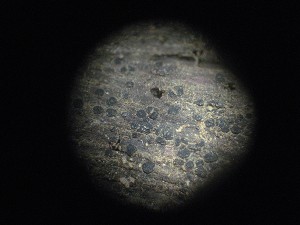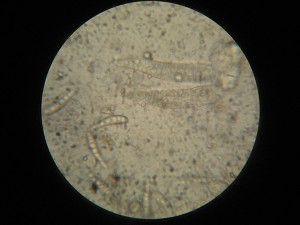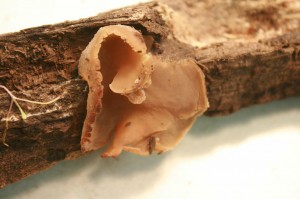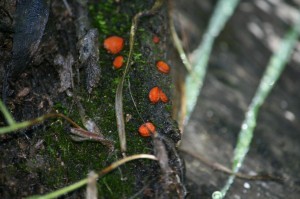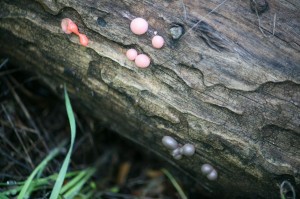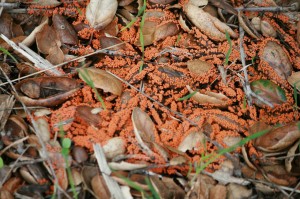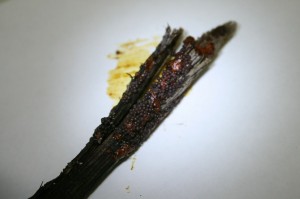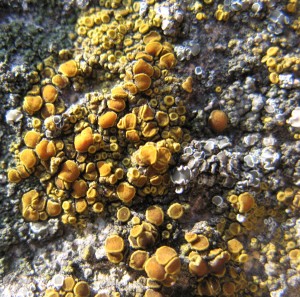Contumyces rosellus – Photo by Betina Xeimariou
L.A. – Palm trees and traffic at dusk
First collecting spot – near Travel Town Parking Lot
Seepage Area Collecting Site – not far from Travel Town Parking Lot
Mushroom Hot Spot by oak tree along trail near Seepage Area
Collecting Mushrooms at Griffith Park for the All-Fungi-Survey
Griffith Park Mushroom Foray – 2013
Griffith Park Mushroom Foray: 2013
Griffith Park Mushroom Foray – 2012
Griffith Park Mushroom Foray – 2016 (photo by Gerry Hans)
Justina has joined our Griffith Park Mushroom Taxonomy Group !
Griffith Park is a 4300 acre park in Los Angeles. It is a huge city park which, by comparison with Central Park’s 800 acres, seems even larger. It has hiking trails that ascend to 1500 foot hill tops, and contains habitat suitable for mountain lions. It also has about 500 different kinds of plants that grow in the park. There are people who study the plants, the birds, the reptiles and mammals, and the insects, but until now nobody has studied the mushrooms of Griffith Park. This is a preview, of sorts, of what we have been finding in the park. Our collecting has been restricted, so far, to early February the past 5 years. We have also just surveyed the very small area at the extreme north-central part of the park on the above map, the area near the Travel Town parking lot. So far, we have recorded about 100 different mushrooms. We hope to find hundreds more in the years to come.
Checklist of the Mushrooms of Griffith Park (Griffith Park photos and updated names and notes to follow, and better photos will replace those not as good)
February 13, 2012: only about a dozen mushrooms seen
February 9, 2013: about 40 mushrooms identified
February 11, 2013: 6 or so (short excursion)
February 10, 2014: 6 or so (very dry)
February 6, 2015: 30 or so species in the Gate Area
February 9, 2015: 50+ species near the Travel Town Parking Lot
February 15, 2016: 40 or so species identified
Altogether, 7 two hour or so forays and more than 100 species identified in a very small area of Griffith Park
————————————————————-
GRIFFITH PARK CONSOLIDATED CHECKLIST
100+ Mushroom species collected to date, most identified to species
GILLED MUSHROOMS
Agaricus bitorquis
Agaricus californicus
Agaricus campestris
Agaricus deserticola
Agaricus semotus
Agaricus xanthodermus
Agrocybe pediades
Agrocybe sp.
Amanita ocreata
Armillaria mellea
Bolbitius (vitellinus) tutibans
Camarophyllus sp.
Cheimonophyllum candissimus
Chlorophyllum brunneum
Clitocybe brunneocephala
Clitocybe nuda (Blewit)
Clitocybe odora
Clitocybe cf rivulosa (Sweater)
Clitocybe sp.
Conocybe tenera
Conocybe sp.
Contumyces rosellus
Coprinus atramentarius
Coprinus lagopus
Coprinus micaceus
Coprinus plicatilis
Crepidotus applanatus
Entoloma sericeum
Entoloma cf vernum
Galerina marginata (autumnalis)
Galerina cf vittiformis
Gymnopus (Collybia) dryophilus
Gymnopus quercophilus
Gymnopus
Hemimycena sp.
Inocybe geophylla
Inocybe sp.
Lactarius rufulus
Lepiota decorata
Lepiota sp.
Lepiota sp.
Leratiomyces ceres
Lyophyllum
Marasmiellus sp.
Marasmiius calhouniae
Marasmius oreades
Marasmius plicatulus
Marsmius quecophilus
Mycena acicula
Mycena aurantiomarginata
Mycena pura
Mycena sp (white)
Omphalina sp.
Omphalotus olivascens (Jack O’lantern)
Pluteus cervinus
Pluteus cf nanus complex
Pluteus petasatus
Psathyrella candolleana
Psathyrella longipes
Psathyrella piluliformis (hydrophila)
Psathyrella uliginicola
Psilocybe sp.
Russula cyanoxantha
Schizophyllum commune
Stropharia ambigua
Stropharia riparia
Tetrapyrgos subdendrophila
Tubaria sp.
Volvopluteus (Volvariella) gloiocephala
Several collections still to be identified
BOLETES
Boletus chrysenteron
Boletus dryophilus
Boletus truncatus
POLYPORES (very few seen)
Phellinus sp.
Trametes hirsuta
Trametes versicolor (Turkey-tail)
CRUST and PARCHMENT FUNGI (many more seen but hard to collect and harder to identify)
Botryobasidium sp.
Hyphodontia sp.
Peniophora albobadia
Peniophora spp.
Phlebia radiata
Phlebia sp. (white)
Phlebia sp. (yellow)
Phlebia sp. (tan)
Stereum gausapatum
Stereum hirsutum
Stereum ostrea (?)
Stereum sanguinolentum ?
Several undetermined as yet
GASTEROMYCETES
Battarrea phalloides
Bovista pila
Bovista plumbea
Cyathus sp.
Disciseda candida
Tulostoma sp.
ASCOMYCETES (possibly as many as there are gilled mushrooms but few have been collected or studied so far)
Chlorociboria cf aeruginascens
Diatrype stigma
Diatrypella sp.
Hypomyces chrysospermus
Mollisia cinerea
Patellaria atrata
Peziza badia complex
Scutellinia scutellata
MYXOMYCETES (Slime Molds)
Arcyria sp.
Hemitrichia sp.
Lycogala epidendron
Reticularia (Enteridium) lycoperdon
Stemonitis sp.
———————————————————————————————–
A few references to help you learn about these mushrooms:
Wood, Michael, et al. “California Mushrooms” – the book to use here!
Arora, David. “Mushrooms Demystified”
Davis, Sommer and Menge. “Field Guide to Mushrooms of Western North America”
Lincoff, Gary. “The Audubon Society Field Guide to North American Mushrooms.”
Mykoweb.com – An excellent website for California mushrooms
LAMS – Los Angeles Mycological Society – its annual mushroom fair in early February at the LA Arboretum is a must attend!
————————————————————-
NOTE on the classification of these mushrooms: The collecting together of mushrooms with “gills” or “pores” or “spines” or those called “puffballs” does not denote relationship. Rather, these are adaptations, or ways in which the spores are produced and dispersed. It is a field-friendly but artificial way of learning to recognize the mushrooms we find. The names of the species given below are often just names of groups or complexes of species, the individual species requiring microscopic study, even DNA sequencing. Still, we are able to recognize a large number of these groups in the field with nothing more than our eyes, nose, and in some cases taste.
Although this is an artificial grouping of the mushrooms we find, this is what works best in the field. The mushrooms below are arranged according to the following groups: (A) Gilled Mushrooms, (B) Boletes, (C) Polypores, (D) Crust Fungi, (E) Jelly Fungi, (F) Gasteromycetes, (G) Ascomycetes, (H) Myxomycetes, and (I) Lichens. Of these groups, only the Myxomycetes (Slime Molds) are not true fungi, but that is not apparent in the field, where they are thought to be fungi.
——————————————————————
(A) GILLED MUSHROOMS…..So far, only 4 of the gilled mushrooms seen in Griffith Park are ectomycorrhizal (that is, have a symbiotic root relationship with trees). These are the Amanita, Inocybe, Lactarius, and Russula. There are others but they have not been seen, so far. The rest of these gilled mushrooms are decomposers……So far, about 35 different genera of gilled mushrooms have been identified in Griffith Park. While not all the mushrooms in these genera have been identified to species, it is likely that we have seen about 75 different species of gilled mushrooms so far.
- – - – - – - – - – - – - – -
AGARICUS…….This is the genus of our cultivated white button mushroom, as well as the Cremini and the Portobello, which are not only all species of the genus Agaricus, but cultivated forms of the same species of this genus, Agaricus bisporus. There are more than 2 dozen species of Agaricus in California. Many are common in urban and suburban areas, especially parks. Agaricus is a genus that is easy to recognize in the field, but many of its species are exceedingly difficult to identify. Some are known to be good to excellent edibles but others are known to be poisonous and cause GI upsets upon ingestion. Immature specimens of some species of Agaricus (those that have white gills when very young) can also be confused with a deadly mushroom, Amanita ocreata (the Destroying Angel) – see below.
Examples of Agaricus species in Griffith Park – not identified to species yet:
Agaricus sp. #1 (photo: Gerry Hans)
Agaricus sp. #2 (photo: Gerry Hans)
Agaricus bitorquis
Agaricus californicus
Agaricus campestris
Agaricus semotus
Agaricus xanthodermus
————————
Agrocybe pediades
Agrocybe sp.
- – - – - – - – - – - – - – - -
AMANITA…..
Amanita ocreata (Destroying Angel)
- – - – — – – – – - – -
Armillaria mellea complex (Honey Mushroom) (photo: Gerry Hans)
Bolbitius vitellinus
Camarophyllus sp.
Cheimonophyllum candidissumus
Chlorophyllum brunneum
Clitocybe nuda (Blewit)
Clitocybe odora
Clitocybe cf rivulosa (Sweater)
Conocybe tenera
Contumyces rosellus (photo: Betina Xeimariou)
————————–
COPRINUS…..
Coprinus atramentarius
Coprinus lagopus
Coprinus micaceus
Coprinus plicatilis complex (photo by Ludmilla)
————————————————–
Crepidotus applanatus
Entoloma sericeum
Entoloma cf vernum
————————————————–
GALERINA…..
Galerina marginata (autumnalis) (Deadly Galerina)
Galerina cf vittiformis
Gymnopus (Collybia) dryophilus
Inocybe sp.
Lactarius rufulus
Lepiota decorata
Lepiota sp.
Leratiomyces ceres
Marasmiellus sp.
Marasmius calhouniae
Marasmius oreades
Marasmius plicatulus
Marasmius quercophilus
Mycena acicula
Mycena aurantiomarginata
Mycena pura
Omphalina sp.
Omphalotus olivascens (Jack O’lantern)
Pluteus cervinus (Fawn Mushroom)
Pluteus petasatus
Pluteus cf granularis
Psathyrella candolleana
Psathyrella longipes
Psathyrella piluliformis (hydrophila)
Psathyrella uliginicola
Psilocybe sp.
Russula cyanoxantha
Schizophyllum commune (photo by Ludmilla)
Stropharia riparia
Tubaria sp.
Volvariella gloiocephala (speciosa)
—————————————————————–
(B) BOLETES…..Only 2 boletes have been seen in Griffith Park. There are others to be found here.
Boletus chrysenteron
Boletus dryophilus
Boletus cf truncatus
————————————————————–
(C) POLYPORES…..Despite searching for them, we have seen very few polypores in the park.
Phellinus sp.
Trametes versicolor (photo by Ludmilla)
————————————————————–
(D) CRUST FUNGI…..There are many more crust fungi than listed here, but many of them are flush against their woody host, and can only be collected with a saw or sharp knife, and then identified with a microscope.
Botryobasidium sp.
Hyphodontia sp.
Peniophora albobadia
Phlebia radiata
Phlebia sp.
Stereum gausapatum (Bleeding Parchment)
Stereum hirsutum
Stereum ostrea
———————————————
(E) JELLY FUNGI…..No jelly fungi have been recorded, so far, but Tremella aurantia has to be in the park because it is a parasite of the very common crust fungus Stereum hirsutum.
———————————————
(F) GASTEROMYCETES (Puffballs and Birds’ Nest Fungi)
Bovista pila
Bovista plumbea
Cyathus sp. (photo: Gerry Hans)
Cyathus ? sp. (photo: Gerry Hans)
Disciseda candida
Tulostoma sp.
________________________________________
(G) ASCOMYCETES……..Nearly every stick or branch on the ground contains tiny, black balls or spots or patches. There could be 50 to 100 different species like this.
Hypomyces chrysospermus
Mollisia cinerea
Patellaria atrata
Peziza badia complex (photo: Gerry Hans)
Scutellinia scutellata (photo: Gerry Hans)
_______________________________________
(H) MYXOMYCETES…..While these are not fungi but organisms related to amoebas, these “slime molds” are frequently “identified” as mushrooms, and the few we have seen are recorded here.
Arcyria sp. (photo: Gerry Hans)
Arcyria sp. (photo: Gerry Hans)
Hemitrichia sp. ?
Lycogala epidendrum (photo: Gerry Hans)
Lycogala epidendrum – spore bearing stage (photo: Gerry Hans)
Reticularia (Enteridium) lycoperdon (photo: Gerry Hans)
Stemonitis sp.
Myxomycete sp. (photo: Gerry Hans)
Myxomycete sp. (photo: Gerry Hans)
________________________________________
(I) LICHENS…..There are a great many lichens in Griffith Park. They are conspicuous crusty or leafy growths on trees, fallen logs, and rock faces. Many show colorful cup-shaped fruiting bodies.


